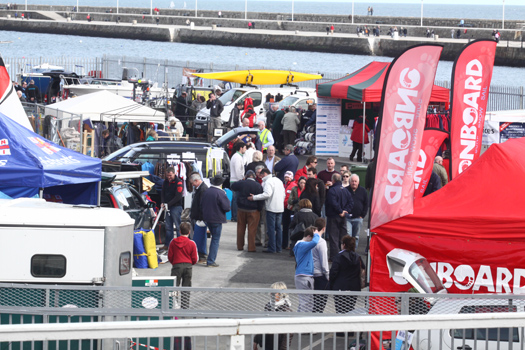Displaying items by tag: Jumble
Three Boat Jumbles Start in March
#BOAT JUMBLE – Three Irish boat jumble sales including a new venue in Cork kick the 2012 boating season off in March and April.
The jumbles commence on Sunday March 25th at the Carlisle Pier in Dun Laoghaire. They continue at the Port of Cork Boat Jumble on Sunday April 15th and it is followed by the Carrickfergus Boat Jumble on Sunday 22nd April on Belfast lough.

The Dun Laoghaire Boat Jumble at the Carlisle Pier
The boat jumbles are open air markets for boating and water sports related gear and equipment old and new and are a great source of boating bargains, value and the unusual.
The Boat Jumble format has proven appeal for trade and "car boot" participants as a low cost way to reaching high number of people with an interest in marine products and services. The essence of the Boat Jumble for water sports enthusiasts is to recycle surplus gear and present value for the buyer.
A range of boating, sailing and water sports equipment and accessories, new and used will be on offer on trade pitches in addition to second hand boats/dinghies, sails, engines and nautical "car boot" items. Friends team up and pool their surplus gear and share the selling task with the one car, many might bring a deck chair and flask ! Some people get together to use the jumble as a means of raising funds for their club, class, and the lifeboat.
Pre booking is essential on the booking form which are available on www.BoatJumble.ie or from the host venue information desk or web site. The cost for a car selling pitch is €30 to include the occupants.
The Boat Jumble format presents an opportunity for the boat owner to reduce ownership costs by converting surplus gear to cash. There is always the opportunity for the boat owner to take stock of the contents of the lazaret, store, shed and sell to keen buyers. Someone else wants that item of gear you no longer use so avail of the recycling opportunity.
The RNLI experts participate by providing a check on personal flotation devices. This important aspect of personal kit is often overlooked so individuals can bring along their PFD and have it check by the experts. This is an important service to the boating public as the season commences.
On site catering and light entertainment make for a pleasant day.The Boat Jumble is a great day for the boating public to find a bargain or that unusual kit suitable for your boat. Admission €5.
To sell at the Boat Jumble (trade pitch or "car boot") pre booking is essential and restricted to marine related products and services.
BOAT JUMBLE DATES
25th March Dun Laoghaire www.dlharbour.ie
15th April Port of Cork www.portofcork.ie
22nd April Carrickfergus www.carrickfergussc.org
Boat Jumbles for Dun Laoghaire, Howth and Carrickfergus
If you fancy a rummage through a Bosun's locker then boat Jumble sales on three consecutive weekends and at three separate locations will satisfy all bargain hunters when the Irish boating season kicks off in a fortnight's time.
Each show is offering a range of boating, sailing and water sports equipment and accessories. There are new and used pitches and some familiar trade names in addition to second hand boats/dinghies and nautical “car boot” items.
The first opens on March 27th – the weekend when the clocks go forward – and it takes place on the Carlisle Pier in Dun Laoghaire Harbour from 10am to 4pm.
The next is across Dublin Bay when the RNLI stage a boat jumble at Howth Yacht Club on Saturday 2nd April from 10.30am to 1.30pm.
The last show is at Carrickfergus on Belfast Lough and this 'Irish Boat Jumble' is being promoted as the 'biggest' in Ireland. The Antrim show will be on Sunday 10th April starting at 10am.
All are offering economical rates and friends are being encouraged to team up and pool their surplus gear and share the selling task!
























